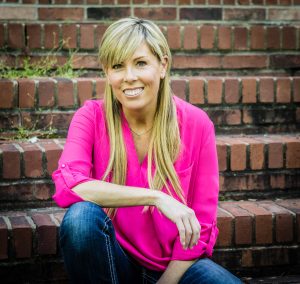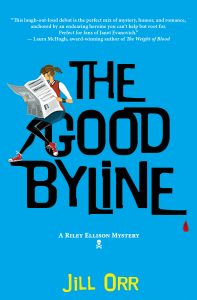Place Settings
 I’ve often said that I could live in an airlock in outer space for the rest of my life and never miss fresh air. Fresh baked bread, I’d miss. But sunshine, a cool breeze, and the way the moonlight dances across the surface of the ocean?
I’ve often said that I could live in an airlock in outer space for the rest of my life and never miss fresh air. Fresh baked bread, I’d miss. But sunshine, a cool breeze, and the way the moonlight dances across the surface of the ocean?
Meh. Suffice it to say, I am not what you would call an “outdoorsy” person. So when it came time to choose a setting for my novel The Good Byline, the last thing in the world that I thought about was the physical environment. But that doesn’t mean that place isn’t an important factor in the book. It simply means that for me, place is about much more than the view outside your window.
Ultimately, I decided to set my novel in the fictional town of Tuttle Corner, VA. I did not choose Virginia for its natural beauty, of which it has plenty, or because I have any special knowledge of the region.
The truth is that I have never lived in this area of the country, unless you count the summer I interned in Washington DC— which you definitely shouldn’t because I spent the entire summer in a three-block radius around a falafel stand in Georgetown. I chose Virginia because at the time I started writing the book, I was visiting my in-laws in Williamsburg, and there was something about the place spoke to me.
Actually, it was an elderly friend of my mother-in-law who spoke to me. Listening to this native Virginian, a true Steel Magnolia, tell me stories about the old days with her honey-colored, gravel-studded voice, I was instantly charmed. I knew that a place in which families go back nine generations and people easily stretch two syllable words to three (and sometimes four!) was a place I could set a spell, and a novel. And because I don’t like to bother with things like “facts” and “accuracy,” the fictional Tuttle Corner— just a stone’s throw from Williamsburg— was born.
 Unlike many other books, place in The Good Byline has everything to do with the people who live there and next to nothing to do with geography, topography, cartography, bibliography, or any other “ography.” It has very few physical descriptors of the landscape or weather or architecture of Tuttle Corner, but the where of the story is still central to the narrative.
Unlike many other books, place in The Good Byline has everything to do with the people who live there and next to nothing to do with geography, topography, cartography, bibliography, or any other “ography.” It has very few physical descriptors of the landscape or weather or architecture of Tuttle Corner, but the where of the story is still central to the narrative.
As a person who prefers her air conditioned, naturally I wouldn’t look to reveal the characters through their relationship with the environment. Instead, I focused on other regional factors like language, local customs, history, political culture, and even generalized personality traits specific to that area of the country.
This is not to say that regional behavioral reputations are always accurate reflections of all people who live in a particular place. We’ve all heard of the warm and friendly New Yorker, the uptight Californian, or the understated Texan. And I know plenty of narcissists right here in the Midwest. But a lot of smart people have spent a lot of time coming up with things like mood maps of the United States that identify the general personal characteristics that tend to cluster in certain areas. These resources can be enormously helpful to the writer who wants to set his or her work in a place where they do not actually live.
As I got to know the Mid-Atlantic region from afar, I used what I learned about the people who live there to populate the fictional town of Tuttle Corner. It is part of the unique pleasure of writing fiction to get to insert oneself into a new place, learn about it, manipulate it, and even become a part of it in some way.
I don’t pretend to be from Virginia, but I do believe I’ve developed an understanding of the culture there, and certainly a deep appreciation for it. I’ve even learned things like what kind of flowering trees grow in southeastern Virginia, the average temperatures for June, and what time the sun sets in September. Yes, it turns out even if you prefer to use a programmable thermostat to control the environment around you, you cannot escape the realities of nature. Or at least your characters can’t. Unless they live in an airlock in outer space, which is probably another book— and another genre— all together.
—
Jill Orr lives in Columbia, Missouri with her husband and two children. Jill’s debut novel The Good Byline is the first in the Riley Ellison mysteries and was published in April 2017 by Prospect Park Books. The next book in the series will launch in April 2018. Visit her at www.jillorrauthor.com
About THE GOOD BYLINE
“Who knew obituaries could be this much fun?”
— Gretchen Archer, USA TODAY–bestselling author of the Davis Way Crime Capers
Meet Riley Ellison, a quirky young library assistant who has become known in her hometown of Tuttle Corner, Virginia, as Riley Bless-Her-Heart. Riley’s odd habit of living vicariously through people she reads about in the obituary pages hits a little too close to home when she is asked to write one for her childhood best friend, Jordan James. Jordan’s unexpected suicide has left Riley desperate to understand why a young woman with so much to live for would suddenly opt out, so she steps out of her comfort zone and into the role of obituary writer.
Things get messy, however, when Jordan’s co-worker, a paranoid reporter with a penchant for conspiracy theories, convinces Riley that Jordan’s death was no suicide. He leads her down a dangerous path toward organized crime, secret lovers, and suspicious taco trucks. Eventually, Riley’s serpentine hunt for the truth leads to a discovery that puts everything she holds dear—her job, the people she loves, and even her life—in danger. Will writing this obituary be the death of her?
Category: Contemporary Women Writers, On Writing































Nice, Jill!
Hope you are doing well!